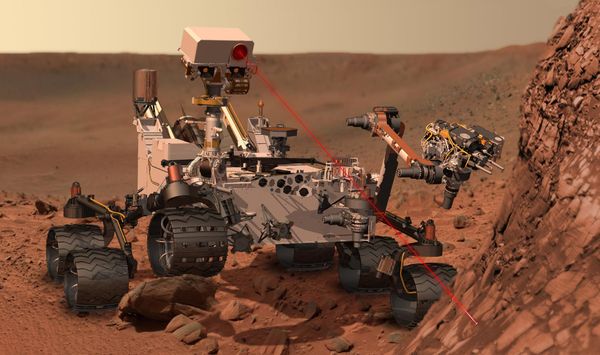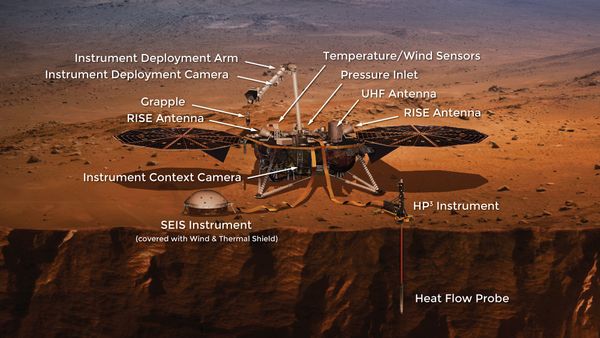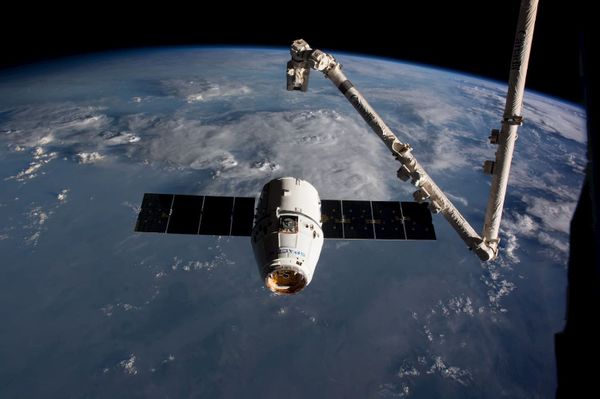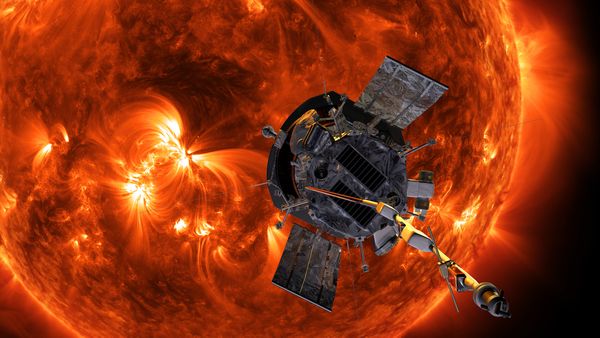Subscribe on iTunes, Google Play, or by RSS for more space exploration discussions. (Jim Bridenstine, OmegA, and SLS mobile launcher
Credit Orbital ATK)
This week on SPEXcast we talk about news from the 34th Space Symposium, political intrigue behind Europa Clipper, and the admission of defeat by the Russian space company ILS.
34th Space Symposium
The 34th Space Symposium was in Colorodo Springs from April 16th through April 19th. This annual conference brings big names in space exploration all in one place. Several key individuals gave speeches at the conference covering NASA culture, space regulations, and new launcher initiatives.
Vice President Pence provides updates on National Space Council
Vice President Mike Pence (@VP) gets a tour of Dream Chaser from the Ozmens, the husband-and-wide team who own @Sierra Nevada Corp. #34SS pic.twitter.com/I6iSURFapf
— Brian Berger (@Berger_SN) April 16, 2018
Vice President Pence spoke at the Space Symposium, primarily to give an update on the National Space Council. The Council was reformed by the current administration last year to provide overarching guidance for the United States' space activities. A major topic at their prior meetings has been how to reduce regulatory burden on up and coming space companies.
Pence: announcing former STRATCOM commander Jim Ellis will be the chair of the Users Advisory Group for the National Space Council. #34SS
— Jeff Foust (@jeff_foust) April 16, 2018
While the National Space Council is made up primarily of U.S. Cabinet members and the Administrator of NASA, the Users Advisory Group is a body that allows key members of the space industry to have a voice. Executives like Tory Bruno and Gwynne Shotwell are slated to have a role. The group gives these organizations a voice in directing space policy.
Pence: regulatory reforms recommended at the prior National Space Council meeting will be signed into policy by president in the near future. #34SS
— Jeff Foust (@jeff_foust) April 16, 2018
Pence: will soon send first comprehensive space traffic management policy to president for his approval. Commerce Dept will provide basic level of SSA info based on DOD data. #34SS
— Jeff Foust (@jeff_foust) April 16, 2018
Space traffic management will increasing be a problem as the frequency and volume of space launches increases over the coming years. 'Traffic jams' are already occurring at U.S. launch sites like Cape Canaveral and Vandenberg. NASA's InSight mission is launching from Vandenberg because the important interplanetary mission needs to reserve the launch pad for an extended period of time in case of delays. Kennedy Space Center couldn't accommodate the long window.
Small satellite launchers are also planning to drastically increase the rate of launches using smaller, cheaper launchers. You can read more about these companies in our deep dive.
Pence: NASA will lead the way back to the Moon. NASA astronauts will return to the Moon. #34SS
— Jeff Foust (@jeff_foust) April 16, 2018
Lightfoot: I realize this chart is not to scale, but it is to scale in terms of priorities. #34SS pic.twitter.com/9ADn7QYdrN
— Jeff Foust (@jeff_foust) April 17, 2018
The current administration and the National Space Council have consistently resolved to focus on the Moon first instead of Mars. Commercial companies like Blue Origin and SpaceX are modifying their heavy lift plans to accommodate potential commercial contracts to the Moon.
Robert Lightfoot Out; Jim Bridenstine In
The Space Symposium offered Acting NASA Administrator Robert Lightfoot the opportunity to say goodbye and offer his final thoughts on NASA and his time with the organization. On Thursday, the Senate finally confirmed the nomination of Jim Bridenstine to the role of NASA Administrator, ending the longest gap in NASA's history without an official, confirmed Administrator.
Lightfoot: we need to get better at assessing risk and decision velocity. #34SS
— Jeff Foust (@jeff_foust) April 17, 2018
Lightfoot: when we sell a mission, we do so on the risk. Then we forget about the benefit and talk about the risk. Overfocus on one part of the risk trade will get you into trouble. #34SS
— Jeff Foust (@jeff_foust) April 17, 2018
Lightfoot: when we make mistakes, we usually fix it by adding something to the process. Can end up being vicious cycle. Worry it becomes more about the process than the product. #34SS
— Jeff Foust (@jeff_foust) April 17, 2018
Lightfoot talks about one case where a new approach would free up funding, but he was warned he would likely get a letter from GAO about it. “I get a couple letters a week from them.” #34SS
— Jeff Foust (@jeff_foust) April 17, 2018
Lightfoot: I wonder if we would have every launched the Apollo missions, or first shuttle mission, in the environment we’re in today. #34SS
— Jeff Foust (@jeff_foust) April 17, 2018
With the incredibly slow progress of first Constellation, and now SLS, Lightfoot's statements have some merit to them. The rate at which NASA development programs have progressed has slowed down over time. This is especially notable now that commercial companies like SpaceX, Boeing, and Sierra Nevada Corporation are taking over some of the responsibilities NASA once held with regards to spaceflight. New Space appears to be innovating at a much greater velocity than NASA's internal programs.
Lioghtfoot: we need to move from risk management to risk leadership. Risk management says the safest place to be is on the ground. Risk leadership says that’s the worst place to be. #34SS
— Jeff Foust (@jeff_foust) April 17, 2018
The confirmation of Jim Bridenstine ends a chapter of political intrigue for NASA and could bring some exciting changes to the nearly 60 year old organization. Jim bridenstine was originally nominated as the next NASA administrator last September. The nearly 7 month delay in confirmation came down to a few factors. Bridenstine is not a part of the existing NASA bureaucracy, but rather a Congressman. Previous Administrators have been prior NASA scientists, engineers, or astronauts. Bridenstine also has a history of anti-climate science claims. The final confirmation vote went 50-49 across party lines.
Bridenstine could be a breath of fresh air for NASA. Someone outside the existing bureaucracy may be able to affect change from the top down. Bridenstine has also showed support for commercial initiatives in space, working closly with the FAA Office of Commercial Space Transportation. He also pushed for the Space Renaissance Act which is pro-commercial space and sought to reform military space contracting to be more efficient.
However, Bridenstine does not have experience managing large organizations. Also with an organization like NASA which is so large and geographically diversified, a top-down culture change may be impossible. At the end of the day, the main guiding force for NASA's direction is via Congress and appropriations bills, rather than NASA leadership.
OmegA
As a part of the 34th Space Symposium, Orbital ATK announced the name of their new Next Generation Launcher, OmegA. You can read all about this new rocket in its own blog post.
Europa Clipper has a fan in Congress
Eric Berger dove into the political manuevering behind the Europa Clipper and SLS recently. He primarily focused on John Culberson, a Republican Congressman from Texas who is one of the primary supporters of the Europa Clipper mission. Europa Clipper is an orbiter designed to map the surface of Saturn's moon. Analysis of the surface and the water plumes from its hidden ocean might lead to new hints of life on the planet. It is also a key mission to support a future Europa lander, which could send a probe under the ice to explore the hidden oceans of this frozen moon.
John Culberson has been critical part of pushing Europa Clipper into a real mission. He recently helped appropriate $495 million for the mission as well as pushed NASA to build a second Mobile Launch Platform (MLP). There had been some controversy on the MLP, with reports that the tower is leaning. NASA had estimated it would take 33 months to upgrade the MLP to support SLS Block 1b, the improved version of the rocket that would finally take crew into orbit. By directing NASA to build a second MLP, Culberson removed a critical roadblock in the timeline of launching Europa Clipper. His actions are a very relevant example of the role of Congress in the type of missions NASA undertakes.
ILS backs away from Commercial Launch
Ars Technica reported on comments by Deputy Prime Minister Dmitry Rogozin, the leader of Russia's space activities.
"The share of launch vehicles is as small as 4 percent of the overall market of space services...The 4 percent stake isn’t worth the effort to try to elbow Musk and China aside. Payloads manufacturing is where good money can be made."
International Launch Services is the public facing provider of Russian launch vehicles for commercial satellites. Initially a collaboration between Lockheed Martin and Energia, ILS now launches exclusively with Proton rockets. Over the years Proton has suffered a variety of high-profile failures. This, coupled with increased competition from SpaceX and others has reduced Russia's share of the global launch market to just 10%.
Rogozin's comments are interesting, as he brings up China as a primary competitor. China is not really in the news for its space launch activity, since the majority of launches are relatively secret government payloads, and no livestreams are available. However, China is in second place for most launches in 2018 so far, only beaten by SpaceX by a single launch.
Note: RIT SPEX is running a crowdfunding campaign! Help support RIT students gain experience and skills through hands-on aerospace projects.







